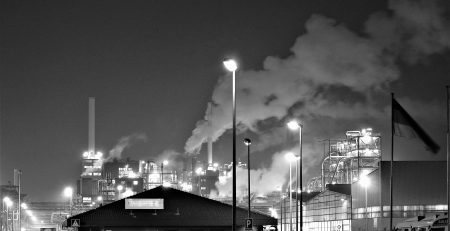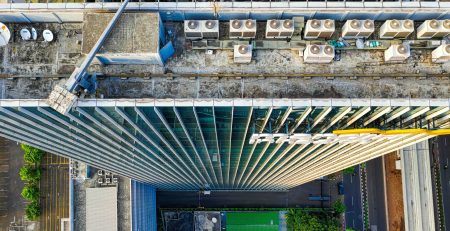Energy Efficiency Starts with People
Every building tells two stories: one written by its systems, and the other by the people who tend them. Too often, we fixate on the first—on fancy controls, AI dashboards, and endless streams of data—while the second remains untold. At BAARCH, we believe true energy performance emerges from the intersection of human curiosity and engineering rigor. This isn’t about more technology; it’s about nurturing an engineering mindset that sees buildings as living systems, guided by questions, observations, and hands‑on care.
1. The Engineering Mindset: Curiosity as Our Compass
When you walk into a plant room, what catches your attention first? The hum of chillers, the glow of control panels, the endless stream of data points scrolling on the BMS screen? These are the signs of modern buildings—but they tell only half the story.
At BAARCH, we believe true energy performance begins with questions, not with hardware. Before prescribing a solution, we pause to understand:
- What the equipment is telling us
We run our hands along pipework, feeling for hidden leaks. We listen for irregular hisses or vibrations that no sensor flags. - What the controls are hiding
We lift ceiling tiles and peer into ductwork to find stuck dampers, orphaned bypass lines, or insulation gaps—failures the BMS never logs. - How people interact with the system
We shadow operators and review logbooks, discovering workarounds, overrides, and habits that drive energy waste.
This isn’t busywork. It’s critical diagnosis:
“No fault code can rival the insight of a walk‑through.”
Only once we’ve mapped the real behavior of both machines and people do we move to solutions—whether that means a simple recalibration, a minor software tweak, or, in rare cases, new equipment.
Key Practices of an Engineering Mindset
These rituals ensure curiosity becomes routine, not an afterthought.
- Monthly Setpoint Sanity Checks: Confirm temperatures, pressures, and schedules align with actual occupancy patterns.
- Quarterly Root‑Cause Reviews: Revisit every unresolved alarm older than 30 days to uncover systemic issues.
- Operator “What‑If” Sessions: Invite frontline staff to suggest hypotheses—often the spark for breakthrough optimizations.
By weaving these practices into every audit and retrofit, we transform static systems into responsive, low‑carbon partners in performance.
2. Efficiency: The First Fuel
Before chasing new technologies, we capture the cleanest and cheapest energy available: the energy we already waste. We call efficiency the “first fuel” because every kilowatt‑hour saved today costs less and cuts more carbon than any new source we could add tomorrow.
When BAARCH begins an efficiency engagement, we follow three core steps:
- On‑Site Waste Identification
We start with simple inspections: feeling pipe surfaces for cold spots that signal missing insulation, observing fan and pump run times against building schedules, and checking temperature differences across heat exchangers to spot fouling or airflow imbalances. These hands‑on checks uncover the gaps no dashboard reports. - Targeted, Low‑Cost Fixes
Once we know where waste occurs, we focus on the highest‑impact, lowest‑cost solutions:- Sealing leaks and repairing insulation to stop obvious heat loss
- Balancing airflow and adjusting dampers so fans and coils work as designed
- Aligning control schedules with real occupancy patterns to eliminate off‑hour operation
- Built‑In Performance Tracking
To ensure savings stick, we define a handful of straightforward metrics—such as off‑hour run‑time or average temperature drop across coils—and track them monthly. Any deviation from target values triggers a quick, focused maintenance response, keeping the building lean without major overhauls.
“Efficiency isn’t an add‑on. It’s the foundation of every decarbonization strategy.”
By making efficiency our first step, each project delivers rapid payback and immediate carbon reduction. And when the time comes to add renewables or advanced systems, they work on top of a streamlined, well‑tuned building—amplifying both performance and return on investment.
3. Behavior First, Tech Second
No amount of sensors or algorithms can fix a system if the people using it don’t share the same goals. At BAARCH, we’ve seen well‑designed control sequences overridden daily, and complex analytics ignored because staff weren’t onboarded. Real energy savings start when technology aligns with human behavior.
Why Behavior Matters
- Routines override schedules. An empty conference room left lit and cooled isn’t a control failure—it’s a habit.
- Manual overrides mask issues. Frequent overrides often hide control logic that doesn’t match real‑world needs.
- Training gaps create blind spots. If operators don’t understand why setpoints exist, they’ll treat them as suggestions.
Our Three‑Step Approach
- Observe and Engage
We spend time with facility teams, walking through spaces at different times of day, and asking open‑ended questions: “What frustrates you about the system?” or “When do you find yourself hitting the override?” These conversations reveal the hidden workarounds that drive waste. - Co‑Design Simple Solutions
Rather than imposing new software, we collaborate with operators to refine control sequences and build clear, easy‑to‑follow procedures. This might mean adjusting a schedule based on true occupancy patterns or creating a quick reference guide for common overrides. - Reinforce Through Feedback
We set up simple dashboards—projected on a break‑room screen or shared via email—that show small, incremental improvements tied directly to staff actions. Celebrating each success keeps teams motivated and reinforces positive habits.
“Technology supports change, but people create it.”
By putting behavior at the center, we ensure that every technical improvement delivers its full potential. When operators feel ownership, overrides drop, schedules align, and analytics become a trusted tool rather than an ignored report. Next, we layer in the controls and data—always as a complement to a solid human foundation.
4. Passive Design: Forgotten Fundamentals
Long before smart controls and AI, builders relied on simple design principles to keep spaces comfortable and energy use low. Yet today, these tried‑and‑true strategies often sit idle, bypassed by the promise of technology. At BAARCH, we believe that passive design—using the building itself as a tool—remains one of the most powerful levers for efficiency.
Imagine a mid‑season day when outdoor temperatures hover in the ideal range. Instead of reaching for the thermostat, a well‑designed façade uses shading to block direct sun while admitting diffuse daylight. Operable windows invite natural breezes, flushing out heat without a single watt of electricity. Thermal mass—concrete floors or masonry walls—absorbs warmth during the day and releases it at night, smoothing temperature swings.
These strategies work because they align with nature’s rhythms, not against them. And they cost little beyond thoughtful planning or minor repairs. Yet on many modern buildings, shading louvers remain fixed in one position, windows are sealed shut for fear of security or noise, and daylight sensors are disconnected in favor of constant artificial lighting.
Bringing Passive Design Back
- Restore Operable Controls
Unlock windows and automate louvers so occupants can harness fresh air and shading based on real conditions. A simple schedule that closes louvers at high sun angles and opens them when skies are overcast can cut cooling loads by a clear margin. - Optimize Daylighting
Re‑angle light shelves, clean glazing, and calibrate daylight sensors so natural light drives down electric lighting during daytime hours. Even a 10 – 20% reduction in lighting use adds up over a year. - Leverage Thermal Mass
Expose thermal mass where possible—polished concrete floors, brick walls—and tune HVAC schedules to charge and discharge that mass. Pre‑cooling or pre‑heating a heavy slab during off‑peak hours can shift energy use to lower‑cost periods and smooth demand peaks.
“Passive design isn’t old technology; it’s timeless logic.”
By restoring these fundamentals, buildings gain resilience and reduce reliance on mechanical systems. When passive strategies and modern controls work together, you get the best of both worlds: low‑tech savings and high‑tech precision.
5. Audits Still Matter: From Data to Discovery
In an age of endless dashboards and real‑time analytics, the humble site audit can feel old‑fashioned. Yet at BAARCH, we consistently find that on‑site inspections uncover insights no screen ever will—and drive the most reliable energy savings.
When we arrive, we’re not just checking boxes; we’re seeking stories behind the numbers. A dashboard might show a fan running all night, but only a walkthrough reveals that a night‑shift technician leaves an override switch on. Trend data can flag high hot‑water use, but only peeking inside a riser closet shows a leaking valve dripping into a floor drain.
The Three Pillars of a Powerful Audit
- Walk the Spaces
We move through every zone—offices, conference rooms, plant rooms—at various times of day. This helps us observe how actual use differs from the design intent. - Inspect the Details
We open panels, peek under floors, and trace pipes. We look for insulation gaps, stuck dampers, sensor misalignments, and any manual workarounds that escaped automated monitoring. - Talk to the Team
We discuss daily routines with facility staff and occupants. Their firsthand experiences—notes about odd noises, recurring overrides, or comfort complaints—often point directly to hidden waste.
“Dashboards highlight anomalies; audits explain them.”
An effective audit doesn’t end with a report; it sparks action. We translate each finding into clear, prioritized recommendations—whether it’s a control‑logic fix, a maintenance task, or a quick training session. By combining data with ground‑truth discovery, audits become the bridge that turns insight into lasting energy performance.
6. Maintenance as a Climate Strategy
Buildings don’t break; they wear out—and without regular care, even the best systems drift into inefficiency. At BAARCH, we treat maintenance not as a cost center, but as a powerful climate strategy. When coils grow dusty, valves begin to leak, and sensors fall out of calibration, small losses add up to major waste.
Our philosophy is simple: equipment should perform as designed, every day. To make that happen, we embed maintenance into the very heart of operations:
- Clean and Calibrate
We schedule regular coil cleanings and damper inspections. Calibrating sensors and actuators ensures the building-management system makes decisions based on accurate data, not drifted values. - Seal and Balance
We hunt down air and steam leaks, tighten valve packing, and rebalance airflow. Properly balanced systems deliver the right amount of conditioned air or heat, eliminating the constant struggle between too hot and too cold. - Recommission and Refresh
Rather than a one‑off commissioning at startup, we perform lighter “health checks” throughout the year: verifying control sequences, testing safety interlocks, and updating documentation so that tweaks and repairs never get lost.
“If you’re not maintaining it, you’re not managing it.”
By making these practices routine—complete with monthly maintenance rounds, clear handover procedures when staff change, and quick‑turn reporting—we keep buildings running at peak efficiency. Maintenance becomes more than fixing failures; it becomes the ongoing work that protects past investments, prevents new problems, and drives continuous carbon reduction.
7. Right‑Sizing Over Over‑Sizing
Oversized equipment often feels like a safe choice—better to have extra capacity than none. In reality, running too‑large chillers, boilers, or pumps at low loads wastes energy, causes cycling losses, and drives up maintenance costs. At BAARCH, we champion “right‑sizing”: matching equipment capacity closely to actual demand.
Why Oversizing Fails
- Low load inefficiency: A chiller operating at 20 % of its capacity consumes proportionally more power than one running at its design point.
- Frequent cycling: Boilers that fire on and off rapidly to meet small heat loads suffer wear and poor part‑load performance.
- Throttled pumps and fans: Large motors throttled by dampers or control valves run outside their optimal range, reducing system efficiency.
Our Right‑Sizing Approach
- Demand Profiling
We analyze actual load profiles—cooling or heating demand over time—to determine the true peak and typical operating ranges. This often reveals that systems rarely need full capacity. - Capacity Adjustment
Where possible, we retune or downsize equipment settings. For staged plants, we may disable one chiller or adjust pump VFD limits so that remaining units run closer to their sweet spot. - Continuous Monitoring
We establish basic metrics—such as percent‑load run hours—so building operators can see when equipment consistently runs below its optimal range and plan for future right‑sizing projects.
“Right‑sizing is not just about replacing gear; it’s about optimizing what you already have.”
By aligning equipment size with real demand, buildings use less energy, experience fewer mechanical stresses, and see lower operational costs—all without the upfront expense of new installations.
8. Data with Purpose: Turning Numbers into Insight
In today’s buildings, data flows constantly: temperatures, flow rates, energy meters, occupancy sensors. But raw data alone is like a library filled with books no one reads. At BAARCH, we treat data as a tool for asking better questions, not as the answer itself.
When we dive into a project, our first step is to let the data guide our curiosity:
- Spot Unseen Patterns
Hourly load curves reveal ghost loads—systems running at full power during late nights or weekends. Trend lines expose slow drifts in setpoints that, over months, translate into significant waste. - Challenge the Assumptions
A design document might promise 50 % modulating chillers, but energy logs show constant full‑speed operation. By comparing real‐time analytics with on‑site behavior, we uncover mismatches between intent and reality.
From there, we follow three guiding principles:
- Collect with Purpose
We focus only on the metrics that matter—coil ΔT, off‑hour run‑time, zone temperature variance—so analysis stays clear and manageable. Unnecessary sensors or excessive dashboards only obscure the signals that drive action. - Analyze to Ask “Why?”
Instead of presenting charts as conclusions, we use them to spark investigation. A sudden spike in overnight energy use becomes the prompt for a walk‑through; a gradual rise in pump energy signals a need to inspect filter or valve wear. - Translate into Action
Every data insight is paired with a clear recommendation and accountability. If chilled‑water temperature drift exceeds 1 °C, we assign a maintenance ticket. If a zone runs unoccupied for over two hours, we adjust schedules or install simple occupancy controls.
“Data without direction is noise; data with purpose drives performance.”
By weaving focused data analysis into field observations and maintenance protocols, we ensure that every chart, graph, or alert leads to a tangible improvement. Data becomes the compass that guides our engineering decisions, keeps savings on track, and transforms numbers into lasting energy performance.
9. Bringing It All Together: A Human‑Centered Philosophy
At BAARCH, our work is guided by a simple belief: energy efficiency is not a software problem—it’s a human challenge. By weaving together curiosity, hands‑on diagnosis, smart efficiency measures, behavior change, passive design, thorough audits, disciplined maintenance, right‑sizing, and purposeful data, we create a holistic approach that drives real results.
- Start with Curiosity
Every project begins with questions, not tools. A walk‑through uncovers far more than a dashboard ever can. - Capture the First Fuel
Before adding new systems, we stop existing waste through targeted, low‑cost fixes that pay back immediately. - Align Technology with Behavior
We design controls that match how people actually use spaces—empowering operators with clear procedures and simple feedback loops. - Restore Forgotten Fundamentals
Passive strategies—like operable windows, shading, and thermal mass—cut energy use without complexity. - Audit to Discover
Regular site inspections translate data anomalies into actionable insights. - Maintain to Sustain
Routine cleaning, calibration, and recommissioning protect performance gains over time. - Right‑Size for Reality
We match equipment capacity to true demand, avoiding the hidden costs of oversizing. - Use Data with a Purpose
Focused metrics guide targeted actions, ensuring every chart leads to improvement.
By integrating these elements into a single, people‑centered process, we empower building teams to manage energy proactively. The result is more than technical upgrades—it’s a shift in mindset, where every stakeholder takes ownership of performance and carbon reduction.
Ready to Transform Your Building?
If you’re serious about cutting energy waste and carbon emissions—without chasing the next shiny technology—let’s talk. Contact BAARCH today to schedule a no‑obligation energy performance review, and discover how a human‑centered, engineering‑driven approach can unlock real savings in your facility.









